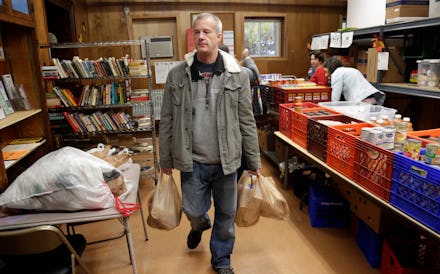4 Powerful Lessons On Today's SNAP Crisis From New York's 1917 Food Stamp Riots

When people abroad imagine the average American family, poverty is not its defining trait. However, recent population data shows that 15% of Americans are living below the poverty line, with rates trending upwards after President Clinton's final term. On November 1, additional funding for the Supplemental Nutrition Assistance Program's (SNAP) included in the 2009 stimulus expired, leaving millions of food stamp recipients with $1.40 a day to spend on food. Economic instability following the recession led to more than 20 million people being added to SNAP, with 1 in 4 American children now living in a home receiving food stamps.
Some have suggested these cuts will lead to rioting in large cities like New York. This would not be unprecedented: The last food riot in New York City took place in 1917 and precipitated a successful boycott of price-gauging pushcart vendors. Here are four things we can learn from what happened in 1917.
1. Rising food prices trigger unrest
A 1916 New York Times interview of an Lower East Side housewife showed that food costs averaged about $22 a month, which was slightly more than half the $40 average monthly salary of American workers. By the beginning of 1917, food prices had skyrocketed to $59 a month!
Rising food prices are a concern in America and abroad, as severe weather conditions, input costs, and increasing global demand push prices up. Although the average American currently living in poverty enjoys a higher standard of living than they would have had in 1917, the inability to meet one's basic needs frequently triggers social unrest.
2. Consumers need protection
Former President Theodore Roosevelt's anti-trust crusade aligned with other populist movements in aiming to improve the average American's standard of living. However, long before the widespread passage of consumer protection legislation, many working class Americans were subject to exploitation by unscrupulous landlords, supervisors, and merchants. Immediately before the 1917 riots, NYC residents began receiving inferior products as costs continued to rise.
Although Americans are now protected against exploitative economic practices, there are still areas vulnerable to exploitation. This country has a long history of organized opposition to unfair practices, frequently leading to dramatic changes in society.
3. Grassroots organization is powerful
Outrage against rising food prices and street vendor practices led housewives from numerous organizations to band together to boycott price gouging, even engaging in vandalism. The protest led City Hall to enforce lower food prices within months.
Organized protest continued to play an important role in society throughout the rest of the century. Today, improvements in technology make it easier for like-minded individuals to band together to effect change.
4. Systemic problems need sustainable solutions
Although the food riots led to almost immediate action by both merchants and the government, price fluctuations continued throughout the first World War. Action had to be taken to prevent further unrest, as economic realities were still conducive to price instability.
Programs such as SNAP are beneficial in alleviating some effects of poverty. The program itself, however, is a reaction to the systemic problem of poverty. In order to truly contrast and eliminate poverty, the millions of Americans currently looking for gainful employment must find work. There are also many troubling societal realities exacerbating the current economic situation. Going forward, long-term solutions should be adopted instead of short-term ones.